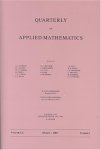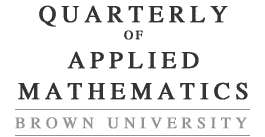The time-dependent Stokes paradox
Author:
S. H. Smith
Journal:
Quart. Appl. Math. 49 (1991), 427-435
MSC:
Primary 76D07
DOI:
https://doi.org/10.1090/qam/1121675
MathSciNet review:
MR1121675
Full-text PDF Free Access
Abstract |
References |
Similar Articles |
Additional Information
Abstract: When a uniform stream starts to flow impulsively at time $t = 0$ past a two-dimensional body, the solution of the Stokes equation indicates that the velocity grows without bound as $t \to \infty$. It is seen that this is a natural extension of the Stokes paradox to unsteady flows. Two resolutions of this result are presented: firstly, through an analysis of the Oseen equation on the basis of singular perturbation theory and, secondly, through considering the two-dimensional body as the limit of a three-dimensional body when the length increases without bound.
G. G. Stokes, On the effect of the internal friction of fluids on the motion of pendulums, Trans. Camb. Phil. Soc. 9, 9–106 (1851)
- Saul Kaplun and P. A. Lagerstrom, Asymptotic expansions of Navier-Stokes solutions for small Reynolds numbers, J. Math. Mech. 6 (1957), 585–593. MR 0091693, DOI https://doi.org/10.1512/iumj.1957.6.56028
- Ian Proudman and J. R. A. Pearson, Expansions at small Reynolds numbers for the flow past a sphere and a circular cylinder, J. Fluid Mech. 2 (1957), 237–262. MR 86545, DOI https://doi.org/10.1017/S0022112057000105
A. Erdelyi, et al., Tables of Integral Transforms, Vol. 1, McGraw-Hill, New York, 1954
- Yun-yuan Shi, Low Reynolds numbers flow past an ellipsoid of revolution of large aspect ratio, J. Fluid Mech. 23 (1965), 657–671. MR 189369, DOI https://doi.org/10.1017/S0022112065001611
- S. H. Smith, The Jeffery paradox as the limit of a three-dimensional Stokes flow, Phys. Fluids A 2 (1990), no. 5, 661–665. MR 1050009, DOI https://doi.org/10.1063/1.857718
G. G. Stokes, On the effect of the internal friction of fluids on the motion of pendulums, Trans. Camb. Phil. Soc. 9, 9–106 (1851)
S. Kaplun and P. A. Lagerstrom, Asymptotic expansions of Navier-Stokes solutions for small Reynolds numbers, J. Math. Mech. 6, 585–593 (1957)
I. Proudman and J. R. A. Pearson, Expansions at small Reynolds numbers for the flow past a sphere and a circular cylinder, J. Fluid Mech. 2, 237–262 (1957)
A. Erdelyi, et al., Tables of Integral Transforms, Vol. 1, McGraw-Hill, New York, 1954
Y. Y. Shi, Low Reynolds number flow past an ellipsoid of revolution of large aspect ratio, J. Fluid Mech. 23, 657–671 (1965)
S. H. Smith, The Jeffery paradox as the limit of a three dimensional Stokes flow, Phys. Fluids A. 2, 661–665 (1990)
Similar Articles
Retrieve articles in Quarterly of Applied Mathematics
with MSC:
76D07
Retrieve articles in all journals
with MSC:
76D07
Additional Information
Article copyright:
© Copyright 1991
American Mathematical Society



